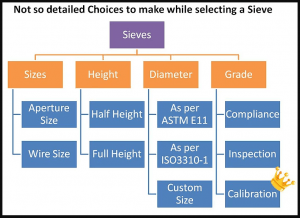From the vast amount of choices that the user has to make to choose the right Sieve for application, I shall try to give you a rough chart of sieve selection. The most important of them is the Grade.
While the ISO standard for analytical wire mesh sieve (ISO3310-1) was revised quite a while ago, the ASTM E11 followed the suite and also introduced three types of certifications for Sieves which divide them in grades. As we can see from the chart
1. Compliance grade Sieve
2. Inspection grade Sieve
3. Calibration grade sieve
Dont’ worry, its not quite complicated as it sounds!
ESSENTIALLY ALL THESE SIEVES ARE MADE WITH THE SAME FABRIC OF WIRE-MESH WITH THE SAME MANUFACTURING PROCESS. As you may have observed or will observe in future that, a Calibration grade Sieve will cost you a bomb as against a compliance sieve.
Here’s essentially why
-
Issuing a Compliance certificate is mandatory for a manufacturer who claims conformance to ASTM E11 or ISO3310-1 standard. Well, the certificate doesn’t or may not give any statistical data which is generated during inspection of the Sieve and just state that, the Sieve Complies with blah..blah..blah standard.
-
The Manufacturer on request of Customer should provide a Inspection grade certificate which mentions the statistical data such as average aperture size, separately in both the warp and weft direction of the wire cloth. Well, the manufacturer may charge you for this.
-
For both Compliance and Inspection grade sieve certification, the same number of apertures are checked, essentially the reason why their prices shouldn’t be poles apart and Thou shall have predicted value of confidence level of standard deviation at 99% for the process of compliance and inspection
-
Many manufacturers underrate compliance sieve just because the users don’t read standards of compliance but, as per standard both compliance and Inspection grade Sieves should be equally accurate and precise.
-
On the other hand sits the Calibration grade sieve, which gets checked for more than double the number of holes than their less fortunate counterparts and Thou shall have predicted value of confidence level of standard deviation at 99.73% for the process of calibration and here comes the important part, the manufacturer must give you results that shall be stated for the number of apertures and wire diameters measured (For a 53 Micron Sieve, that, number is a whopping >500 measurements of the tiny holes!)
-
What does that mean to you?
-
Well, if you are doing super critical work (Rocket Science, Nuclear Science, Critical Medicine) day in and day out heavily relying on Sieving results the 0.73% increase in confidence level is a substantial difference and you should use calibration grade Sieve set.
-
On the other hand if your testing is not a matter of life and death (e.g: Grading Minerals or Cosmetics or Foods for that matter) but the testing is frequent, then you should have one Calibration grade sieve set in wraps to frequent check if your compliance or inspection grade sieve set is in order.
-
if you’re testing is not a matter of life and death (e.g: Grading Minerals or Cosmetics or Foods for that matter) and the testing is infrequent, then you should use compliance or inspection grade Sieve set.
-
Compliance sieve set can only be bought, after using it for a while, when you send it back to manufacturer it shall come back as Inspection grade (Don’t forget to ask for the little statistics we owe you.)
